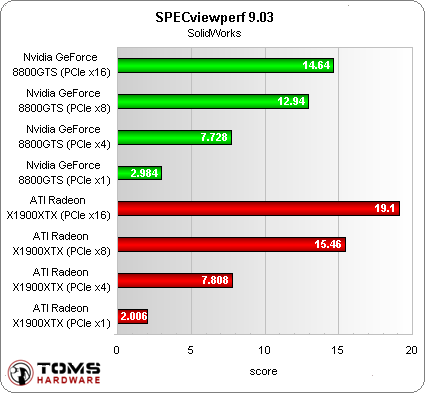PCI Express Scaling Analysis
SPECviewperf 9.03, Continued
The professional OpenGL graphics benchmark SPECviewperf 9.03 is very calculation- and graphics-intensive. This results in relatively high demands for a quick interface. It is interesting to see how well performance scales if you go from x1 to x4 to x8 PCI Express. Switching to x16 PCI Express enables even more performance, but the gains become less significant. Still, it becomes very obvious that professional graphics require high-bandwidth interfaces, so you should definitely go for x16 PCI Express if you intend to intensively run 3DSMax, Catia, Ensight, Lightscape, Maya, Pro Engineer or SolidWorks.
Conclusion
The conclusion of our 2004 PCI Express analysis was simple: x4 PCIe bandwidth typically was sufficient to run single graphics cards without creating an interface bottleneck. At that time, x8 or x16 link widths were not necessary, and AGP was still powerful enough.
However, the situation clearly is different today, as we found that only four PCI Express links are no longer adequate. Although there are differences between ATI/AMD and Nvidia, and between games and professional graphics, most applications deliver best performance at x16 PCI Express speeds. The two 3D games we used - Quake 4 and Call of Duty 2 - certainly cannot be called demanding these days, yet they benefit somewhat from faster link speeds. The professional benchmark SPECviewperf 9.03 was the real eye-opener, as it categorically disqualifies PCI Express link speeds below x16.
The benchmark results make pretty clear that chipsets and motherboards need to be capable of supporting all graphics cards at the full x16 PCI Express speed. If you run high performance graphics cards on inadequate interfaces such as PCI Express x8, you give away performance.
Join our discussion on this topic
Get Tom's Hardware's best news and in-depth reviews, straight to your inbox.

Patrick Schmid was the editor-in-chief for Tom's Hardware from 2005 to 2006. He wrote numerous articles on a wide range of hardware topics, including storage, CPUs, and system builds.

